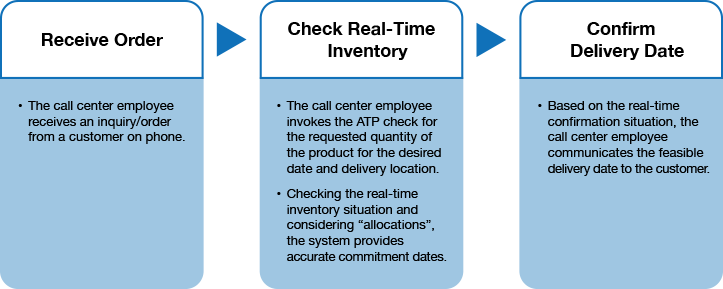Fulfilling Orders with Confidence
Advanced Available-to-Promise Functionality in SAP S/4HANA Boosts Visibility and Profitability
Sales orders are integral to business, and with the rise of e-commerce, they’re only becoming more plentiful. Instead of relying solely on large orders by a handful of retailers, manufacturers now ship many small deliveries directly to customers. As this trend grows, differentiation on delivery — not just in terms of speed and flexibility, but, more important, in sticking to the delivery commitment — is a key factor in the marketplace.
This is what makes available-to-promise (ATP) a core requirement for so many companies. Any time a sales order comes in for a product, there is a requested quantity, time, and location, and companies need to know this information to understand whether they can fulfill the request. But it’s often not just a simple check of inventory and fulfillment — there are many contingencies to consider: What if the order changes at the last moment? What if there isn’t inventory in the main warehouse, but there is in a nearby warehouse? Is there anything happening in the production process that could potentially affect this delivery? With a first-come, first-served (FCFS) strategy, are orders from the top customers getting fulfilled in time over lower-priority orders?
These are the sorts of questions that advanced ATP technology can help companies answer. And now with SAP S/4HANA, this functionality is directly embedded within the solution, no longer involving separate installations or complex integration. SAP S/4HANA recognizes that ATP is core to so many companies’ businesses and provides the technology needed to improve these functions, which extends into the rest of the logistics and supply chain process, so that companies can provide an excellent customer experience and not lose out to the competition.
Gaining Visibility into Fulfillment
We live in an omnichannel world. Whether it’s a website, an app, a retail store, a subsidiary, or anything else, companies sell the same products through many channels. Without proper visibility into these different channels, businesses could struggle with fulfillment and profitability.
Visibility is important because companies are dealing with more sales orders than ever before due to the ease of online purchasing. They still must deliver large orders to business-to-business (B2B) customers but now must also accommodate many more business-to-consumer (B2C) customers. The consequences in these spaces are different, but important.
In B2C scenarios, not meeting delivery dates negatively affects the customer experience, putting some doubt on a customer’s future purchasing activity. But for business-to-business (B2B) scenarios, it’s even more serious. Imagine a B2B manufacturer plans the manufacturing of a product based on the delivery of materials in five days. If it takes seven days, the entire plan is thrown off — suddenly the company has unused labor, machinery, and materials either to redeploy or leave stagnant. A production line that shuts down is going to have negative effects all the way through a business unit — and create a serious problem for the supplier that could not meet its delivery deadline.
Using the advanced ATP functionality in SAP S/4HANA, these sorts of scenarios can be avoided. Companies can provide feasible delivery commitments beforehand, ensuring that they can deliver what they promise. This results in a streamlined order fulfillment process and happier customers.
Maintaining Profitability
It’s one thing to maintain fulfillment effectiveness at its base level, but the next step is to optimize it for profitability. From prioritizing low order processing costs to shortening the order-to-cash cycle, SAP S/4HANA can help companies run their ATP processes profitably.
One way SAP S/4HANA does this is by helping prioritize more profitable channels before others. For example, imagine that a company has five B2B customers, a mix of major retailers and subsidiaries, and on top of that they have opened a new channel where customers can order via a mobile app. However, the company has a limited supply of items, say 100, to distribute among these channels. How does it decide how best to distribute these items? The most obvious answer might be to split it evenly among the channels or to simply operate on an FCFS basis, but not all channels are equal. What if the lowest-priority customer, which sells less than others or involves greater shipping costs, asks for 60 items and then the top customer asks the company for 60 items later? The company no longer has the inventory to fulfill the latter order, thus making for less profitable fulfillment and potentially straining the relationship with the top channel.
In the back order processing functionality that is part of the advanced ATP features in SAP S/4HANA, companies can label orders using a five-category setup:
- Win: Fulfill fully.
- Gain: Fulfill if possible, but orders can’t be changed to a lower confirmation quantity.
- Redistribute: These can gain or lose confirmation quantity as needed.
- Fill: These are the lower-priority orders that can lose confirmations if required, but in no case gain any further confirmation.
- Lose: These are customers that have not paid for months, for example, and shouldn’t have anything fulfilled until they have paid.
Using this mechanism, companies can ensure that the right orders receive the desired fulfillment every time, leading to higher service levels and profitability.
Efficiencies Throughout the Supply Chain — and Beyond
The advanced ATP functionality in SAP S/4HANA comes with a very simple, intuitive mechanism for maintenance of allocations to protect key customers or regions based on defined logic. These allocations ensure that the interests of top-priority customers are protected even when the company has limited supply and employs an FCFS scenario.
Companies also need flexibility for last-minute changes. After running back-order processing overnight, companies often get a last-minute request to change an order in the morning before deliveries are to be created. Let’s say they were planning to fulfill 20 items, but the customer now needs 30. Doing back-order processing again is not possible, but a quick manipulation is needed — with the SAP Fiori app Release for Delivery, the company can find where they can pull the additional items from.
While these features have clear benefits for the entire ATP process more from a supply chain perspective, they also help customer service. Consider a call center employee who receives a call from a customer looking for many products (see Figure 1). The call center employee must check the inventory, check for the right allocations, and provide the accurate date. And this has to be done quickly, while the customer is still on the phone.

More to Come
In the next release of SAP S/4HANA, more features focused on visibility are planned to be released. When looking for alternatives during confirmation — for example, instead of delivering from Chicago, deliver from Minneapolis, or instead of two 10-liter cans, deliver four five-liter cans — traditional ATP employs first-fit confirmation. With the new enhancements in SAP S/4HANA, companies will be able to choose the best alternative based on pre-defined key performance indicators (KPIs), such as selecting the nearest location or the most abundant product. Additional planned features include more analytics, machine learning, capable-to-promise functionality that factors in additional elements such as production capacity and availability of raw materials or components, and industry-specific features such as shelf-life planning.
For more information on how advanced ATP features in SAP S/4HANA can benefit manufacturers, visit https://bit.ly/2n6qwuS.






